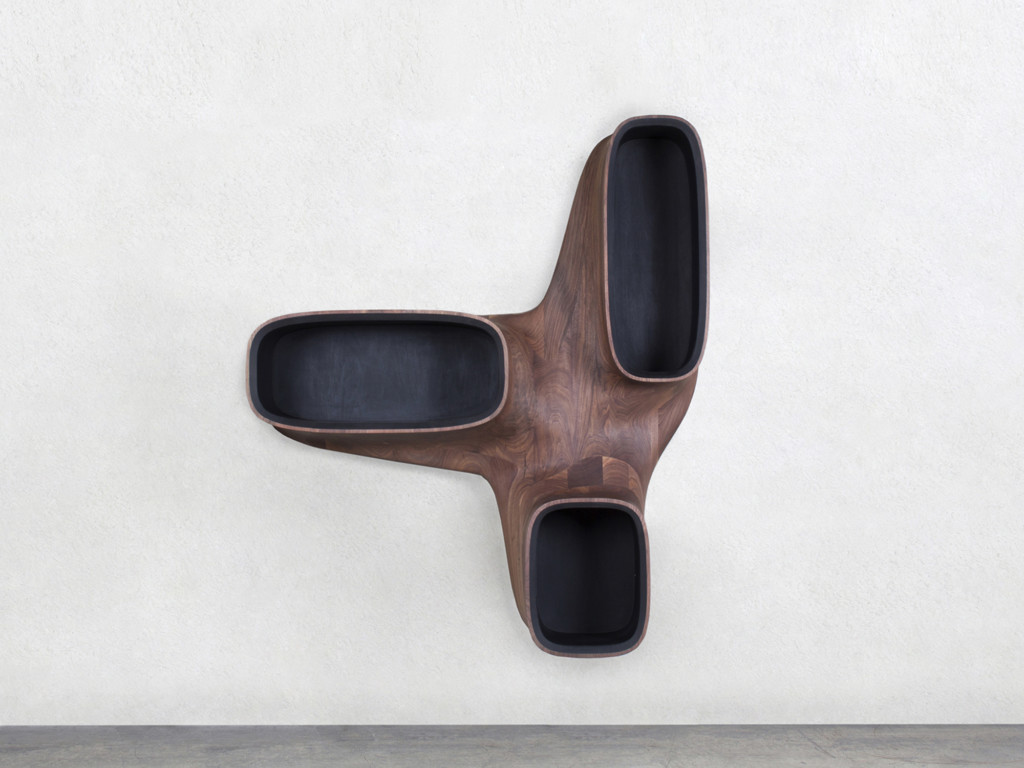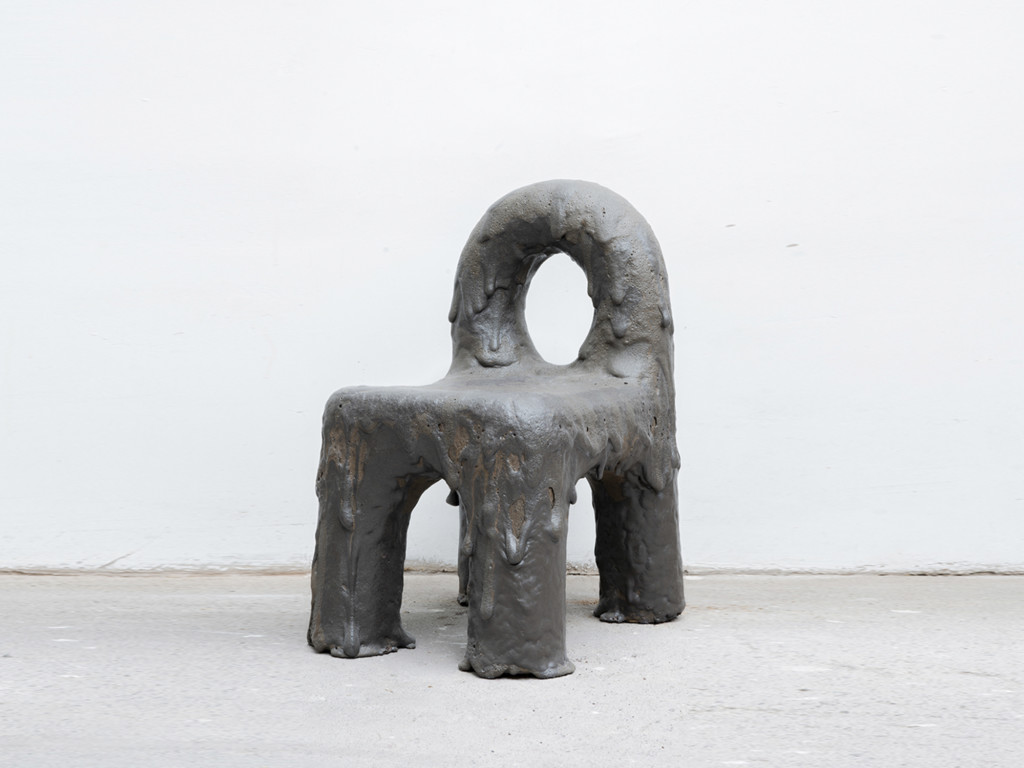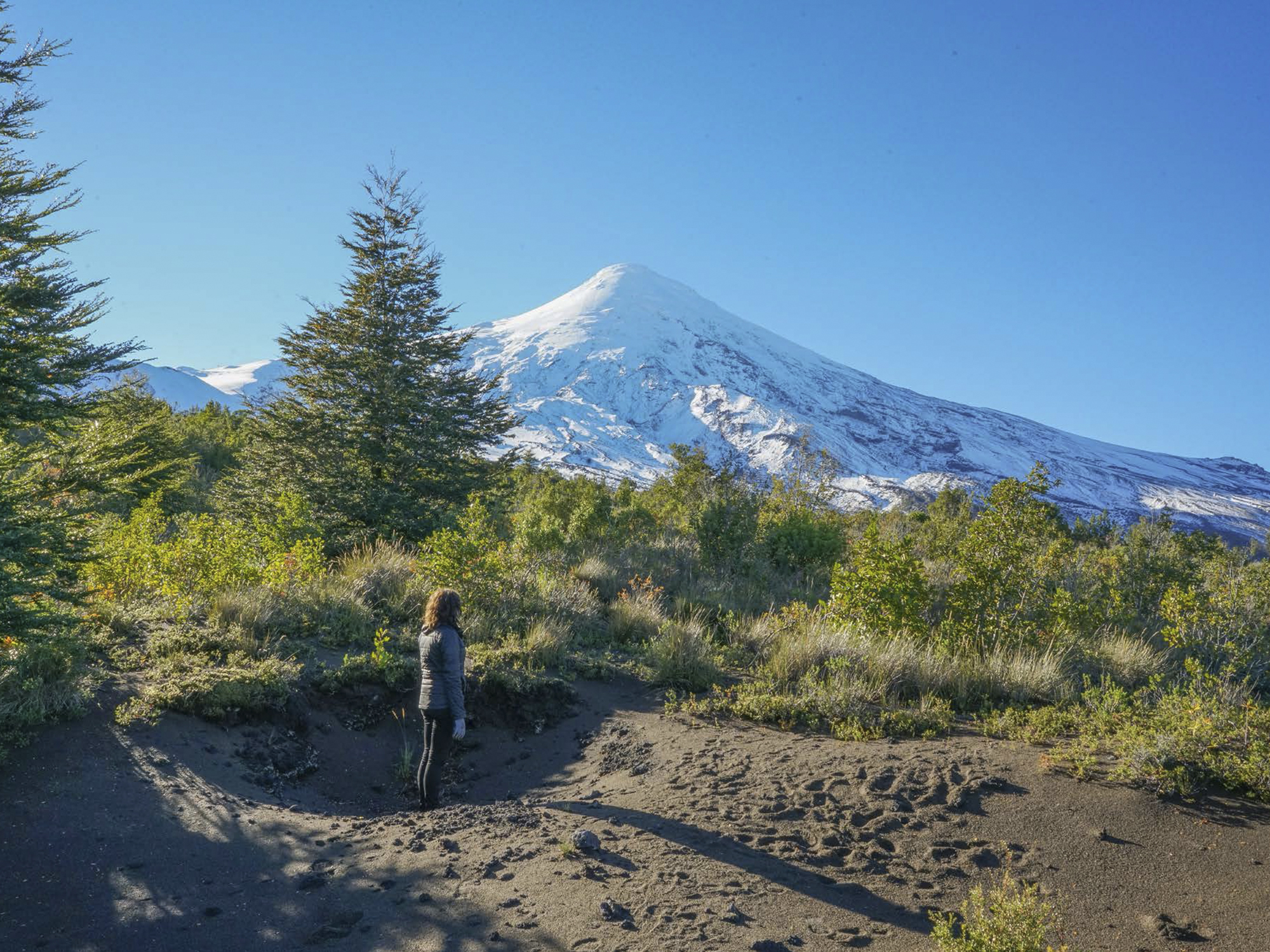Imagine a curve converging with a line. It bends gradually as it approaches, continuing to arc closer and closer, almost becoming parallel to the line, but never – never ever – actually touching it. In geometry, a line approached by that sort of curve, as it heads off to infinity, is called an ‘asymptote.’ It’s a technical term for a figure that is richly suggestive. Which of us have not felt, at some point in our lives, like we were chasing something we could never quite reach?
It’s not customary, perhaps, to open an essay on contemporary design with a bit of mathematics. But in the case of the Chilean designers GT2P, it could not be more appropriate. Over the past decade, they have established themselves on the international scene through the consistent application of a methodology that they call “paracrafting.” Again, that sounds technical, but the concept is simple: everything they do involves creating a set of conditions, or limits, which generate the design. Often this way of thinking does involve math, and the precise control of space, time, tools, or temperature. But it is more than that, too: for GT2P, working within parameters is a way of rethinking what design can be.
GT2P do spend a lot of time in the virtual, but they also apply parametric thinking to purely physical situations. Thus, to understand their point of view, it helps to situate their practice in real space. They are based in Chile, a country whose geography itself feels rather asymptotic –thrilling mountain peaks and low flat plains huddled right along the Pacific, on the west coast of South America. Specifically, they are based in Santiago, a megacity of 7 million people – yet they are well aware that from the perspective of the global design world, they might seem to be out at the end of the world. Certainly, they are not averse to incorporating their locality into the iconography of their work, which often echoes mountains, rivers and oceanic landscapes. But their primary response to their geographical position has been to search for a universal language, one that is equally relevant everywhere, and particularize it in the form of an object. And what is more universal than math?
Paracrafting also feels right to GT2P, perhaps, because of the unusually collaborative nature of their practice. By its very nature, contemporary design tends to be driven by singular personalities – that is how clarity of vision is maintained. Historically, outside the corporate sector, it has mainly been in the context of Radical Design, which seeks to deconstruct the very premise of the “authored” object, that teams have been a dominant presence; one thinks here particularly of Italy in the 1960s and 1970s, and groups like Superstudio, UFO, Global Tools, and Studio Alchymia. GT2P are to some extent informed by that tradition – witness their encoded, quasi-utopian name, like something from a sci fi novel (it’s short for “Great Things To People”). But they are not really interested in avant garde provocation. Their project is more positively framed than that. They want to introduce new, materially intelligent solutions within established production flows, including those that pass through their own country.
As with most effective collaborative teams, each member of GT2P has a distinct role to play. Two of the partners, Guillermo Parada and Tamara Pérez, met when they were undergraduate architecture students; they became partners both in work and life (and today, have two children together). As Master’s students, they met Sebastián Rozas, and at that point formed the studio practice. Through various reconfigurations they have had as many as nine members, but the three founders are still partners, as is Victor Imperiale, who began as an employee of the studio. According to Guillermo, he himself plays the role of external spokesman and creative director; Tamara is the group’s principal craft maker; Sebastián is the principal architectural project manager and digital maker; and Victor is the “geek guy” (I hope he won’t mind seeing that in print), which is to say, the team’s digital developer. But this is indeed a hypercollaborative studio, a machine built for imagining new possibilities. There is also a further level of complexity, in that the group works with many external specialists, from quarry technicians and geologists to software developers and artisans. In this creative terrain, GT2P’s embrace of parameters serves to channel the energy, establishing the course of each project much as a riverbed guides water.
An example of the GT2P methodology at work is their Less CPP lighting, initially developed in 2014 but still being refined on an ongoing basis. This series was born in a device that they call a Pottery Catenary Printer – a catenary being the curve that a hanging rope or string assumes when supported only at its end points. This shape is well-known among art enthusiasts because Jasper Johns adopted it as a signature motif. GT2P chose it independently for much the same reason: it is a “natural” form, mathematically complex but very easy to create in real life. Their so-called printer is a wood frame in which a drape of fabric – gauze, muslin or lycra – is hung from several points. Liquid clay (slip) is poured in, forming a reservoir, and then allowed to dry. This step can then be repeated, building up the thickness of the deposited material, as in a 3D printer. When removed, the clay has captured all the compound curves of the textile; the shape can be varied endlessly by shifting the hanging points and angles.
GT2P actually developed the Catenary Printer as a teaching tool – it swiftly and effectively teaches the principles of paracrafting, even to people who have no experience with mathematical calculation. But they soon realized that it was also a powerful form-generator. First they developed a series of porcelain bowls, each one a unique ruffled shape. Next they turned their attention to lighting, hoping to exploit the translucency of porcelain, and also to illuminate the beautiful “tidal” lines made by pouring multiple layers of slip. This was effective in producing a visually variegated and luminous fixture, but for practical reasons, they needed to introduce an anchor point.
It was here that lava came into the equation. They had been experimenting with this abundant but unused natural Chilean resource for some time, and realized that the melting points of some volcanic stones coincided perfectly with the firing temperature of porcelain. Within a certain heat range, the lava would melt just as the ceramic hardened. Exploiting this convergence, they began to make lights with a central lava mount, partially diffused into and thoroughly bonded into the porcelain. By varying the materials and temperature of the kiln, they could achieve subtly different effects of color and interaction between the two materials.
This initial experimentation with lava encouraged the studio to pursue the material further, eventually culminating in their first major breakthrough on the international stage: the Remolten Revolution series. Here, GT2P again pair lava and ceramic, but the former is now the main event. The volcanic stone is ground into a powder and then applied through kiln-firing to the surface of stoneware seating, essentially treating the lava as a ceramic glaze. Through their further experimentation with various volcanic materials, kiln firing along various temperature curves (another set of parameters at work), they have been able to adjust the surface quality on a spectrum from smooth to roughly pitted, as well as its color. As in their use of the Catenary Printer, this application of the paracrafting method takes its inspiration from a naturally-occurring process; as the series title suggests, GT2P are replicating the natural cycle of eruption and cooling within the confines of their own studio.


In their most recent work this implicit orientation toward landscape has become much more overt. The term “suple” is slang used in the Chilean construction industry for an improvised join or transition. It’s something an artisan does when things don’t quite fit, or the right materials aren’t at hand. In any architectural language, much is determined by the system of joints; in the concept of “suple,” we have the basic connective unit of bricolage. GT2P were inspired by this national culture of making-do, but wanted to abstract the idea, honing in on the way that a builder might integrate standard mass-produced units into a more flexible ad hoc structure.
And so, they went to the drawing board. This time they applied parametric design in a very literal way, first creating basic geometrical arrangements, and then shaping curved connective tissue around them. Their research led ultimately to two discrete groups of objects. The first, called Suple Bounding Form, is derived from a set of arbitrarily juxtaposed rectilinear volumes. This geometric situation is used to generate a set of compound contours, embracing the hard-edged blocks; it’s as if a viscous liquid were being virtually poured around a set of blocks. The first renders in the design process are choppy, faceted polygons, but by dividing these shapes into an ever-finer mesh, it’s possible to achieve a totally smooth form. Once finally rendered on-screen, the shapes become the basis for CNC-milled wooden objects. (And I’m guessing this is where “the geek guy” comes into his own.)
The computer-generated shapes that result from this involved process are remarkably intuitive in feeling. Like a digital version of natural erosion, paring down the “envelope” produces a seemingly accidental aesthetic quality, a taut and undulating compound curvature – rhythm found through algorithm. The starkness of the original geometrical juxtaposition, in which simple boxes are surrounded by a kind of attractive force field, is also preserved in the finished pieces. GT2P’s choice of materials is important here, too. They have used a North American walnut, warm and organic, but the recessed forms are heavy and black, possessed of tremendous gravitas. They communicate a sensibility at once ancient and futuristic, prompting thoughts of the monolith in Stanley Kubrick’s 2001: A Space Odyssey.
The second series, Suple Connecting Form, is logically similar but departs from a different geometrical premise. First, a convergence of lines in 3D digital space is established, then a volume is defined around it, a single complex sleeve that encloses all of the axes. As in Suple Bounding Form, after the initial shape is generated, its topology is refined to create a smoothly articulated surface; but in this series, the digital output is rendered as a model for casting in metal. The result is a kind of “super joint” which can be used to attach pre-existing elements like wooden or metal beams, or linear lighting fixtures, into a complex configuration. Through this mechanism, GT2P have been able to realize their original intention of bridging the world of the mass-produced and the customized. “New technology is just another tool,” they say. “It will not replace our history. We have to make it compatible with our heritage.” In their most extraordinary application of this idea to date, GT2P have made an enormous, asterisk-like seating sculpture, with a single mighty cast Suple joint in the center. Beams of varying lengths are inserted into the vertex, one at breathtaking extension, allowing several people to sit. The sculpture can be anchored to the floor at the other end, but for the Manufactured Landscapes exhibition GT2P have decided to use a natural rock, a little fragment of Chile, to give stability. Though abstract, the seating sculpture echoes the riverside meetings of trees and banks where the members of the group recall playing as children.
Both of the Suple collections exploit the power of parametric methods to generate endless variations on a single idea – the conceptual DNA for a whole design family – but they also remain rooted in direct material experimentation. Guillermo comments that in Chile, there is little call for pure design work: “people don’t pay you for drawings, they pay you for things. So you have to learn how to make things.” Accordingly, all of GT2P’s work involves a complete passage from the abstract to the concrete. But it’s only in their most recent collection, which they call Imaginary Geographies, that this movement has itself become the subject of the work.
The departure point for Imaginary Geographies is not a mathematical shape, exactly; but it is a sound recording, which (as will be seen in a moment) can amount to essentially the same thing. Specifically, GT2P chose to work with the poem “The Imaginary Man” (El Hombre Imaginario) by the great Chilean writer Nicanor Parra. It is worth quoting the first and last verses of the text, to give a sense of it:
The imaginary man
lived in an imaginary house
in the midst of imaginary trees
on the bank of an imaginary river
[…]
And during imaginary moonlit nights
dreams with an imaginary woman
who offered to him (toasting) her imaginary love
once again he felt this same pain
the very same imaginary pleasure
and once again began to palpitate
the heart of the imaginary man
These beautiful lines evoke the very nature of poetic visualization, in which something that exists only in the mind takes on independent life, which may perhaps feel more “real” than reality itself. The text could not be a more fitting basis for GT2P’s own conception. What they did was to take a recording of the poem being recited aloud, and then take “slices” out of its waveforms. This set of curves – naturally occurring, like the catenary, but much more complex – was then CNC carved into furniture. The pieces have a tectonic monumentality, with surfaces that were determined by the chance operations of the design process, yet in the end looking much like the Chilean landscape. An upright credenza features a gradient topology, like a mountain range gradually fading into a broad flat plain. A coffee table has a round basalt inset surrounded by a whorl of carved ripples, strong suggesting a placid lake surrounded by rolling hills. Crouch down by the edge, and you can imagine yourself there, right by the water. GT2P travel a great circle of thought in this body of work – from Parra’s “imaginary river,” along a completely digital pathway, to a miniature world that is real, but prompts imaginings of its own.
The concept of resolution plays an important role in these works. By varying the distance between tool pathways – hence varying the density of the cuts – it is possible to realize textures on a continuum, fractal and faceted at one end, gentle like a rumpled sheet at the other. GT2P note that the rougher the cut, the more the action of the cutting tool itself is telegraphed; through slower successive passes, this language is edited out, coming closer to a clean transcription of the original digital file. It’s yet another example of a parameter at work. But again, there is more going on here than pure technique. The Imaginary Landscape objects exemplify the studio’s core principle of “process expressionism.” In exerting fine control over a variable like resolution, GT2P are also acting as translators among multiple languages – that of the tool, that of the poem, and that of the material. As they point out, paracrafting in the broadest sense would take into account not only numerical parameters, but cultural ones as well.
In the Imaginary Landscapes series, GT2P have achieved their most impressive body of work to date, combining several seeming antitheses: mathematical and emotional, physical and digital, Chilean and global, collaborative and visionary, concrete and abstract. The collection acts as a proof of concept for paracrafting, which (paradoxically) generates endless possibility out of the logic of limits. Like a curve approaching an asymptote, the work abides by a strict boundary and yet stretches out toward infinity. In this sense, although all their work has a basis in objective process, in number-crunching and laboratory experiments, the results always attain a metaphorical quality, arriving in the world as proofs of human ingenuity. This is the final, and most important, opposition they manage to bridge: that between cool calculation and sheer joy. Spoiler alert: their next big research project, they say, will be about “la fiesta.”
This essay was originally published in exhibition catalogue gt2P: Manufactured Landscapes, Friedman Benda, New York, NY, 2018.










